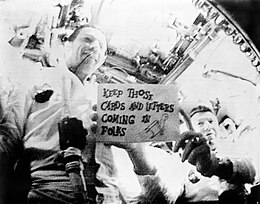 Apollo 7 transmitted the first live television broadcast aboard a crewed American spacecraft. | |
| Mission type | Crewed Earth orbital CSM flight (C) |
|---|---|
| Operator | NASA[1] |
| COSPAR ID | 1968-089A (craft), 1968-089B (S-IVB)[2] |
| SATCAT no. | 3486[3] |
| Mission duration | 10 days, 20 hours, 9 minutes, 3 seconds |
| Orbits completed | 163[4] |
| Spacecraft properties | |
| Spacecraft | Apollo CSM-101 |
| Manufacturer | North American Rockwell |
| Launch mass | 36,419 pounds (16,519 kg)[5] |
| Landing mass | 11,409 pounds (5,175 kg)[6] |
| Crew | |
| Crew size | 3 |
| Members | |
| Callsign | Apollo 7 |
| Start of mission | |
| Launch date | October 11, 1968, 15:02:45 UTC |
| Rocket | Saturn IB SA-205 |
| Launch site | Cape Kennedy LC-34 |
| End of mission | |
| Recovered by | USS Essex |
| Landing date | October 22, 1968, 11:11:48 UTC |
| Landing site | North Atlantic Ocean 27°32′N 64°04′W / 27.533°N 64.067°W[7] |
| Orbital parameters | |
| Reference system | Geocentric |
| Regime | Low Earth orbit |
| Perigee altitude | 227 kilometers (123 nmi)[2] |
| Apogee altitude | 301 kilometers (163 nmi)[2] |
| Inclination | 31.6 degrees[2] |
| Period | 89.55 minutes[2] |
| Epoch | October 13, 1968[8] |

 Left to right: Eisele, Schirra, Cunningham | |
Apollo 7 (October 11–22, 1968) was the first crewed flight in NASA's Apollo program, and saw the resumption of human spaceflight by the agency after the fire that had killed the three Apollo 1 astronauts during a launch rehearsal test on January 27, 1967. The Apollo 7 crew was commanded by Walter M. Schirra, with command module pilot Donn F. Eisele and Lunar Module pilot R. Walter Cunningham (so designated even though Apollo 7 did not carry a Lunar Module).
The three astronauts were originally designated for the second crewed Apollo flight, and then as backups for Apollo 1. After the Apollo 1 fire, crewed flights were suspended while the cause of the accident was investigated and improvements made to the spacecraft and safety procedures, and uncrewed test flights made. Determined to prevent a repetition of the fire, the crew spent long periods monitoring the construction of their Apollo command and service modules (CSM). Training continued over much of the 21-month pause that followed the Apollo 1 disaster.
Apollo 7 was launched on October 11, 1968, from Cape Kennedy Air Force Station, Florida, and splashed down in the Atlantic Ocean eleven days later. Extensive testing of the CSM took place, and also the first live television broadcast from an American spacecraft. Despite tension between the crew and ground controllers, the mission was a complete technical success, giving NASA the confidence to send Apollo 8 into orbit around the Moon two months later. In part because of these tensions, none of the crew flew in space again, though Schirra had already announced he would retire from NASA after the flight. Apollo 7 fulfilled Apollo 1's mission of testing the CSM in low Earth orbit, and was a significant step towards NASA's goal of landing astronauts on the Moon.
- ^ Orloff, Richard W. (September 2004) [First published 2000]. "Table of Contents". Apollo by the Numbers: A Statistical Reference. NASA History Series. Washington, D.C.: NASA. ISBN 978-0-16-050631-4. LCCN 00061677. NASA SP-2000-4029. Archived from the original on August 23, 2007. Retrieved July 6, 2013.
- ^ a b c d e Orloff & Harland 2006, p. 173.
- ^ "Apollo 7". NASA. Retrieved October 23, 2020.
- ^ "Apollo 7 (AS-205)". National Air and Space Museum. Archived from the original on July 4, 2017. Retrieved October 23, 2020.
- ^ "Apollo 7 Mission Report" (PDF). Washington, D.C.: NASA. December 1, 1968. p. A-47. Archived (PDF) from the original on October 9, 2022. Retrieved December 11, 2020.
- ^ Orloff & Harland 2006, p. 180.
- ^ "Apollo 7". National Air and Space Museum. Retrieved October 23, 2020.
- ^ McDowell, Jonathan. "SATCAT". Jonathan's Space Pages. Retrieved March 23, 2014.